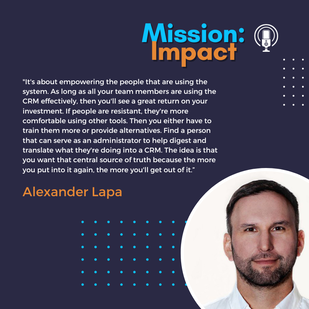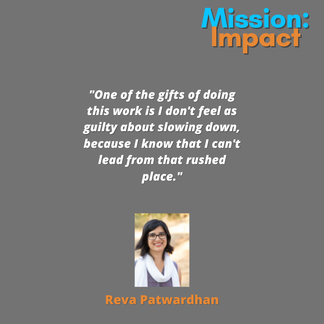Mission: Impact podcast & blog
Build a better world without becoming a martyr to your nonprofit cause
Listen on:
|
Too often I get calls from potential clients with the question – can you come facilitate our strategic planning retreat next month. Unfortunately the answer is usually no. Why? Because it does not allow time for a full process that builds success. Strategic planning is not just about getting together at a retreat – the retreat or series of planning sessions are an important part of the process – but not the whole process itself. What is strategic planning?Nonprofit strategic planning is the process to take stock, gather input from your stakeholders, evaluate your organization’s strengths and challenges and set strategic goals for a specific time period. A well conducted process will help ensure that everyone is aligned and working on the things that matter most to moving your mission forward. It helps your organization step back and consider where you are now and where you want to go. It provides you with the opportunity to get reconnected with your stakeholders and understand how they see your organization, its strengths and areas for growth. Why is strategic planning important for nonprofits?Ultimately strategic planning is about building excitement and alignment throughout your organization for your vision, as well as the key goals that emerge as part of the process. It helps you shift from your focus on the day to day to think about your organization from a wider lens and longer perspective. When done well, it engages and aligns all the people important to your organization’s future behind a shared vision and set of goals. Learn more about the five step process of strategic planning. Should the strategic planning process include a retreat? Does it need one?Yes a retreat or a series of planning meetings are part of the process. You will need to set aside time to bring your board and staff together to talk through where you are currently, vision where you want to be and then prioritize the steps to getting from here to there. But the retreat or series of planning meetings are just part of the process - they are not the process themselves. What does the process look like beyond the retreat?Strategic planning is a more comprehensive process that takes work ahead of the retreat to be prepared to use the time together well as well as time after the retreat to shift from vision to action. Deciding what the key areas of strategic inquiry is an important step. With that understanding, gathering input from your stakeholders is a foundational step in the process. You are essentially going on a listening tour. This can be a piece of the process where it is particularly helpful to work with an outside consultant. The data gathering phase can be time intensive and challenging for staff or volunteers to complete in addition to their regular workload. In addition, those you want to gather feedback from are more likely to be fully candid with someone outside the organization. Considerations for planning your retreat or planning sessionsYou will need to decide who to invite, how long will you set aside, will the retreat or planning sessions be in person or online and who will lead the retreat/sessions. Typically a strategic planning task force made up of both staff and board members will help inform the answers to these questions. I recommend inviting both board members and staff. They each bring a unique perspective to the process. Whether you are able to meet for a day, a day and a half or a series of shorter sessions will determine how much of the agenda items below you can cover. If coming together for a full day, day and a half or two days will not work for your group, consider doing a series of shorter planning sessions online. What should the strategic planning retreat focus on?ith the foundational steps completed – especially the gathering of input from stakeholders – you are then well positioned to hold your retreat or series of shorter planning sessions. While every organization’s needs will be different, typically a retreat agenda will include: · a review of the findings from the stakeholder input process and a discussion of their implications; · a scan of the wider trends impacting your organization; · envisioning your organization’s future · identifying key initiatives that will help you get from where you are to that envisioned future · drafting action steps and success indicators for each of your key initiatives, and · a review of your mission, vision and values, including how those values are demonstrated in behavior. This can occur over a day or two or through a series of shorter focused planning sessions for each agenda items. When conducting strategic planning online, opting for the shorter focused planning sessions is a better alternative. A day long retreat will NOT be able to cover all these agenda items, so be realistic. What are the benefits of a nonprofit strategic planning retreat?Taking the time to bring your staff and board together has many benefits. These include building relationships, each individual gaining a more wholistic understanding of the organization as well as time away from the crush of the daily to do list to think more expansively. What are the pitfalls of a nonprofit strategic planning retreat?Unfortunately, when retreats are held in absence of a more comprehensive process, they can lack grounding in the current state of the organization. This can result in goals that are not fully connected to the current capacity of the organization or do not address the most pressing issues. They can also result in wish lists of good ideas without a true plan or process for how to implement these and integrate them into the day-to-day operations of the organization. What happens after the strategic planning retreat?At the end of the retreat, you should have a draft of your plan. A smaller group – often a strategic planning task force or committee – will then finalize the plan. Another important task for this group at this stage is to agree on how the plan will be reviewed and updated – how often, by whom. Will this process happen during its own special meeting or will it be integrated into standing board and staff meetings? How do you operationalize the bigger strategic goals?To make sure that your strategic planning process is worth the time invested in it, you need to create not just the overall three-five year strategic plan. You also need to create an implementation plan. You start by choosing a shorter time frame – it could be a quarter, six months or a year – however you already do your planning. Then choose what of the overall plan you will focus on during that time frame. Only then go to the level of detail of who will do what by when. Too much can change over longer time frames to bother trying to nail down all those specifics in the overall plan. Ensure that your team and division leaders understand how their work relates and supports the broader strategic direction and plan so that they can help their direct reports see their part in the organization’s strategy. How do we keep the strategic plan relevant?Ensuring you have processes to monitor and evaluate the plan on a period basis will be key to keeping the plan relevant. Having defined success indicators, you will be able to measure progress and outcomes. Checking in on progress, as well as where you have hit unexpected road blocks, what adjustments need to be made and what may not be as relevant given new realities that it may have seemed when you originally created the plan will all be important to ensure the plan doesn’t just sit on the shelf. Agree on who will be champion tracking progress on the plan. Be flexible and adaptable and not overly attached to the details of the plan as no plan can anticipate all the changes in circumstances that the future will bring. Why is a comprehensive strategic planning process important?Strategic planning for nonprofits is a dynamic and vital process that extends well beyond the confines of just a retreat. It involves thorough preparation, active engagement from all stakeholders, and the integration of feedback into a viable strategic plan. The true power of strategic planning lies not just in the retreat itself but in the continuous, concerted efforts to align the organization's daily operations with its long-term vision.
Remember that strategic planning is an ongoing journey of adaptation and refinement, ensuring that your nonprofit remains responsive to changes and capable of achieving its mission. Embracing the full scope of this process will increase the likelihood of success as you work toward building your organization's impact and sustainability.  In episode 98 of Mission: Impact, Carol Hamilton hosts Danielle Marshall for another learning out loud episode where we do a deep dive into a topic. Today’s topic is leadership in the nonprofit sector, especially the declining interest in nonprofit leadership as highlighted by the "Push and Pull" report by the Building Movement Project. We explore the dual reactions of frustration and affirmation in response to the report, discuss the challenges and support needs of nonprofit leaders, particularly BIPOC leaders, and emphasize the importance of culturally relevant support, universal design, and sustainability in leadership roles. Episode Highlights - [00:06:01] The "Push and Pull" report by the Building Movement Project, tracks the declining interest in nonprofit leadership roles, a persistent issue in the sector. - [00:07:25] The importance of training, mentoring, and coaching, and reflects on her own experience of not knowing she could negotiate for executive coaching. - [00:08:41] The added challenges faced by BIPOC leaders, including gaps in board and staff support and heightened expectations for rapid change. - [00:010:54] The unrealistic expectations placed on nonprofit leaders and the renegotiation of work-life balance. - [00:012:59] The additional pressure on BIPOC leaders who serve communities they identify with, dealing with systemic oppression and trauma patterns. - [00:15:00] Rethinking Leadership Roles with culturally relevant support and universal design and its potential benefits for creating more inclusive and supportive leadership roles. - [00:23:30] The trend of having co-executive directors. Potential and challenges. - [00:28:30] The challenge of always adding new expectations and the importance of focusing on sustainability. - [00:31:01] The importance of boards and staff supporting executive directors in carving out time for development and peer support. The conversation underscores the complexity of nonprofit leadership, the need for systemic changes to support leaders better, and the importance of culturally relevant and sustainable support systems to encourage more people to step into these critical roles. Guest Bio:
Danielle is an inclusive leader focused on strengthening collaboration among teams, leaders, and stakeholders to foster problem-solving, create solutions, and improve culture. She finds her inspiration in leading systemic change work that promotes equity and inclusion. Danielle founded Culture Principles in response to a persistent need to operationalize Racial Equity, Diversity, and Inclusion metrics, centering REDI goals and creating accountability systems. She supports clients through her Mapping Equity Framework focused on Unearthing Knowledge, Elevating Strategy, and Transforming Sustainability. She centers her work around organizational assessment, racial equity learning intensives, and the development of racial equity action plans. Understanding that each organization arrives at this work from different perspectives, she utilizes assessment in building a customized strategy for each unique partner. Previously Danielle served as a non-profit leader for 20+ years and today works on strategy development that enables nonprofits to achieve equitable mission-driven results. Danielle holds a Master's degree in Industrial-Organizational Psychology from Louisiana Tech University and draws on her background as an I/O psychologist in applying a racial equity lens to organizational policies, practices, and programs. She is a Certified Diversity Professional (CDP)/ Executive Coach (ACC). During her playtime, you can find Danielle traveling, knitting, and kayaking in all 50 states. Important Links and Resources: The Push and Pull: Declining Interest in Nonprofit Leadership Related Episodes: E72: Exploring Passion Exploitation with Lauren Brownstein E78: Renegotiating our relationship with work with Carol Hamilton E92: Three stages of nonprofit leadership with Patton McDowell E95: Building shared nonprofit leadership with Emily Taylor Click "Read More" to view a transcript of the interview  In episode 83 of Mission: Impact, Carol Hamilton and Alexander Lapa delve into the benefits of using a Customer Relationship Management (CRM) system like Salesforce for nonprofits. These include improved data management and streamlined processes. Alexander shares his expertise in setting up and optimizing CRM tools for nonprofits. He explains why having a consultant to guide organizations through the complexities of finding the right tool to meet where they are in their stage of development is helpful. The conversation also explores challenges in fully utilizing a CRM system and the need for training and support to empower users as well executive sponsorship. Integration, AI, and organizational culture in nonprofit CRMs are also discussed. Episode Outline:
(00:08:30) Benefits and Challenges for your nonprofit of Using a CRM (00:13:36) Leveraging CRM for Effective Communication (00:18:28) Integration and AI in Nonprofit CRMs (00:23:40) Challenges with CRM Adoption Guest Bio: Alex is a Salesforce Architect & Advisor who helps nonprofits improve their social impact. He has 10 years of Salesforce and nonprofit experience and 20 years of CRM experience. Aside from working on CRM projects, Alex is host of "Agents of Nonprofit". It's a weekly podcast that interviews guests about products and services which help nonprofits. It's often discusses the benefits of technology, and currently has nearly 70 published episodes. Alex also shares his experience in a short daily email, helping junior Salesforce consultants level-up their knowledge, deal with challenging clients, and advocate for a digital nomadic lifestyle. Episode Links: https://dryadconsulting.com/welcome https://www.linkedin.com/in/alexanderlapa https://podcast.agentsofnonprofit.com/ Click "Read More" for Transcript  I love to read. One of my favorite parts of any book is the Acknowledgments section. I haven’t written a book yet - and I may never do that - but I would like to acknowledge all the people this year who were generous enough to have me on their podcast to talk about my favorite subject - nonprofit strategic planning. Every time I get to talk to someone about strategic planning, why I do it and why it is important for nonpropfit organizations, I learn something new about the practice and process. I am not necessarily a “think out loud” external processor and yet through these conversations I deepened my understanding by having to explain things to others that sometimes seem obvious to me. One thing that I certainly have learned over the course of my career is that what is obvious to me - or anyone - is NOT necessarily obvious to others or even how they think about a thing. And that in itself is one of the reasons I love facilitating strategic planning processes. Folks have to talk through with each other what might be obvious to them and implicit in how they work – but needs to get explicit if the whole group is going to get behind the idea and move a strategic initiative forward. Because of that learning and deepening I am so grateful for each opportunity I had to explore the topic this year. Connecting to my valuesDuring my Own Your Expertise interview with Emily Crookston, PhD., I realized that my faith tradition’s 1st and 7th principles - the inherent worth and dignity of every human being and the interconnectedness of all things really undergird my work with nonprofit organizations. I don’t think I had made that connection before we talked. Reevaluating your strategic planIn my conversation with Carolyn Mozell, the host of Use Your Powers for Good podcast, we talk about how to stay accountable to the strategic plan and why it is so important for your nonprofit organization to agree on a process for reevaluating and reviewing your plan on a regular basis - whether that is quarterly, every six months - or at minimum every year. Making the nonprofit strategic planning process worth your timeTalking with Stu Swineford, host of the Relish this podcast, we explored what goes into making a nonprofit strategic planning process worth it. As Stu put it, it’s a valuable exercise that aligns your team, creates thrust for your nonprofit organization, and builds an actionable plan to keep you on track for the short- and longer-term. I really appreciate the idea of a plan helping generate momentum that propels the organization forward. Moving beyond the fears of strategic planningWith Julia Campbell, the host of the Nonprofit Nation podcast, we talked about what people fear about strategic planning and how that gets in the way of making it effective. Letting go of past bad experiences with nonprofit strategic planningBetina Pflug, the host of the Wisdom for Nonprofits podcast, and I talked about the frequent bad past experiences people have had with nonprofit strategic planning and how to make the process fun and useful. And why I do NOT have group’s start with a review of their mission and vision. VUCA doesn't mean planning is uselessDavid Pisarek, host of Nonprofit Digital Success, and I explored why you don’t need to throw out the idea of nonprofit strategic planning even though we do live in a VUCA (Volatile, Uncertain, Chaotic and Ambiguous) world. Nonprofits are essentially a network of people working together towards a common goal. The conversations the group has over the course of a strategic planning process helps everyone get clear about what is really important to focus on in the next 3-5 years and some first steps on how to move towards those goals. Without having those conversations periodically, a lot of “static” builds up in the system and folks may actually be working at cross-purposes instead of in a more powerful, aligned way. It's your nonprofit organization's plan, not mineHugh Ballou, host of the Nonprofit Exchange, and I talked about the myths about nonprofit strategic planning. One we honed in on was why it is important for the group, not the consultant, to write their own plan. Thanks! So thanks again to Emily, Carolyn, Stu, Julia, Betina, David, Hugh. And thanks for the service each of them provide the sector by creating their shows and helping those in the sector learn and deepen their practice.  In episode 53 of Mission: Impact, Carol and her guest, Reva Patwardhan discuss:
Guest Bio: Reva Patwardhan is the founder of Greater Good Coaching. She works with nonprofit leaders who’ve followed their hearts into careers of service and advocacy. She helps them discover their innate strength, resilience and confidence, so they can use their careers to make the impact they want in their lifetimes. She has 20 years of experience in the nonprofit sector as a fundraiser, communications director, lobbyist, board member, facilitator, coach and diversity trainer. Reva co-facilitates small experiential learning groups with the Stanford Graduate School of Business. She chairs the Board of Directors at Rethink Media. She is a certified Integral Coach, and a member of the International Coaching Federation. Important Links and Resources:
Click "Read More" for Transcript: |
Categories
All
Archives
July 2024

Grace Social Sector Consulting, LLC, owns the copyright in and to all content in and transcripts of the Mission: Impact podcast, as well as the Mission: Impact blog with all rights reserved, including right of publicity.
|
Telephone301-857-9335
|
info[at]gracesocialsector.com
|
Grace Social Sector Consulting, LLC, owns the copyright in and to all content in, including transcripts and audio of the Mission: Impact podcast and all content on this website, with all rights reserved, including right of publicity.
|